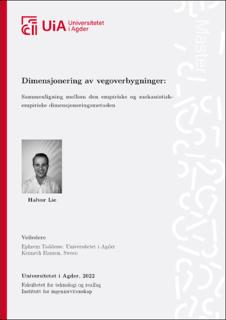| dc.description.abstract | This master’s thesis focuses on different methods for designing pavement structures, mainly the
empirical and the mechanistic-empirical methods. The first one is used in Norway, and the design
is done by following a handbook with empirical data. The other one is up for consideration in
Norway and uses, together with empirical data, mechanistic data regarding the properties of the
different layers measured by a falling weight deflectometer (FWD). The thesis aims to analyze if the
mechanistic-empirical method will reduce the total thickness of the pavement structure compared
to the empirical method. Therefore, the research question is as follows: How does the thickness
of the pavement structure change when using the mechanistic-empirical method compared to the
empirical method?
Different methods were used to solve this question. Handbook N200 was used for the empirical
design, while PMS Objekt was used for the mechanistic-empirical design. To compare the results
between N200 and PMS Objekt, with backcalculated E-moduli. FWD-data was also imported into
the program. The FWD-data are backcalculated in Elmod. E6 Soknedal and E39 Lønset-Hjelset
were used as case-projects for the design of the pavement structures.
When the mechanistic-empirical method is used at E6 Soknedal, the thickness is reduced by 30 cm
compared to the empirical method. For E39 Lønset-Hjelset, where the frost depth is almost one
meter less than in Soknedal, the thickness is raised by 10 cm. This is because the FWD-data used
for this calculation is done on an old pavement structure. That causes low E-modules from the
backcalculation for the different layers, resulting in increased layer thicknesses for compensating the
reduced moduli. Therefore, as long as it is ensured that a valid E-moduli is used, the mechanisticempirical
method will reduce the thickness of the pavement in most cases. In addition to that, the
mechanistic-empirical method also assures that the pavement structure is designed so it would last
its designated lifetime. | |
